Day 10: From Corinth to Eleusis and Back to Athens Again
by KT Amrine and Madeline Young
Corinth (AM): Kt
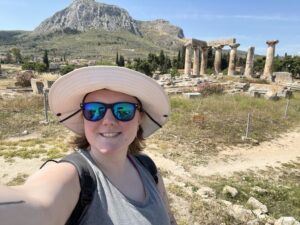 Today began with breakfast at the hotel and a shorter bus ride than we were used to from the past few days. After about an hour and a half of driving, we arrived at the site of Ancient Corinth earlier than expected. We had the privilege of learning about the history and archaeology of the site from site director Dr Christopher Pfaff. Corinth was a mixing pot, much like some places in America, where opportunities for people (specifically freed slaves) drew crowds from all over.
Today began with breakfast at the hotel and a shorter bus ride than we were used to from the past few days. After about an hour and a half of driving, we arrived at the site of Ancient Corinth earlier than expected. We had the privilege of learning about the history and archaeology of the site from site director Dr Christopher Pfaff. Corinth was a mixing pot, much like some places in America, where opportunities for people (specifically freed slaves) drew crowds from all over.
This is what makes the site so interesting: because there were so many people hailing from all over with different languages, cultures, and religions, the artifacts on the site are complex and multifaceted. For example, the temple atop the Acrocorinth (Corinthian Acropolis): was it sacred to Aphrodite of the Greek tradition, or Venus of the Romans?
The first artifact we looked at was the Temple of Apollo, which was preserved through Roman rule in Corinth, unlike some other parts of the city. Now, only a few of its Doric columns are standing strong. It was constructed and carved from local bedrock stone, similar to Glauke’s Fountain nearby. We noted the connection to the play Medea by Euripides.
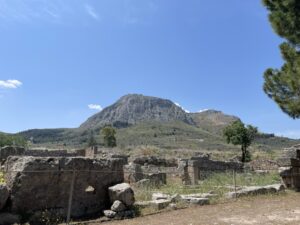 After gazing at a few more structures around the archaeological site, we headed inside the museum to meet up with museum director Dr. Ioulia Tzonou. The museum was set up to encourage viewers to engage with how the objects were found or used in antiquity, with one side of the museum flushed in darkness and the other with open windows and full of light. The organization and curation of the museum was definitely my favorite part. It allowed for a more immersive, entertaining experience than a lot of the museums I’ve seen before, contextualizing the items within the site itself.
After gazing at a few more structures around the archaeological site, we headed inside the museum to meet up with museum director Dr. Ioulia Tzonou. The museum was set up to encourage viewers to engage with how the objects were found or used in antiquity, with one side of the museum flushed in darkness and the other with open windows and full of light. The organization and curation of the museum was definitely my favorite part. It allowed for a more immersive, entertaining experience than a lot of the museums I’ve seen before, contextualizing the items within the site itself.
The most imposing figures upon entering the first side were twin Kourai, recently recovered from illegal excavators (unfortunately we were not able to take pictures here but I encourage you to look them up!). As Dr. Tzonou explained to us, these Kourai represent a tension between the locals and the archaeological site drawing tourists. In order to encourage local Corinthians to contribute to the growing collection of artifacts (should they find any) and support the excavations nearby, the museum does outreach programs with nearby schools and allows locals to feel a sense of ownership over the site and museum. The outdoor section of the museum held a marvelous selection of marble statues, which would have also been placed outdoors in antiquity for viewing.
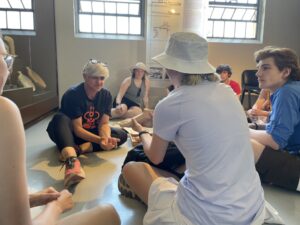
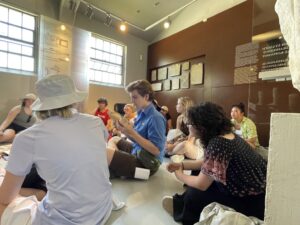 Lastly, we were able to touch some artifacts found at the Asklepieion, or healing sanctuary. It was really cool to finally get to touch something and not have to gaze at it through glass cases! We also got to see and read a curse tablet found on the Acrocorinth, in which one woman was so angry that she cursed another woman to have her period forever and never be able to become pregnant—which, in a society where your memory only lives on if you reproduce, is a cruel, cruel fate.
Lastly, we were able to touch some artifacts found at the Asklepieion, or healing sanctuary. It was really cool to finally get to touch something and not have to gaze at it through glass cases! We also got to see and read a curse tablet found on the Acrocorinth, in which one woman was so angry that she cursed another woman to have her period forever and never be able to become pregnant—which, in a society where your memory only lives on if you reproduce, is a cruel, cruel fate.
Eleusis (PM): Madeline
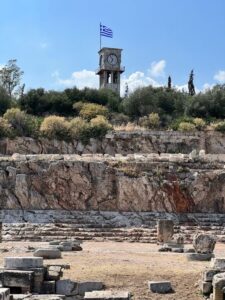 After exploring ancient Corinth with site and museum directors and traveling by bus across the Greek isthmus, we arrived at Eleusis for one last site visit. Eleusis was the home of the mysterious ancient Cult of Eleusis within the sanctuary of Demeter- whose members worshiped the goddess Demeter and her daughter Kore through rites that we still don’t fully understand. KT told us about the cult itself, and about the myths of its origin.
After exploring ancient Corinth with site and museum directors and traveling by bus across the Greek isthmus, we arrived at Eleusis for one last site visit. Eleusis was the home of the mysterious ancient Cult of Eleusis within the sanctuary of Demeter- whose members worshiped the goddess Demeter and her daughter Kore through rites that we still don’t fully understand. KT told us about the cult itself, and about the myths of its origin.
In mythology, Kore or Persephone was the daughter of the harvest goddess Demeter and the god Zeus. The god of the underworld, Hades, desired Kore and stole her (with Zeus’s blessing) while she was playing in the area, taking her with him to the underworld. Demeter was so upset that she spent all her time searching for her daughter, neglecting her duties and causing the people to starve as they had no harvest. Demeter found solace at Eleusis in a kind family, particularly an old woman who cheered her up by making crude jokes. Demeter eventually was reunited with Kore, but they could only be together for a third of the year, since she had eaten pomegranate in the underworld and was thus bound to it. This formed the basis for the cult of Eleusis- for which the penalty for revealing the inner rituals was death: therefore in its over 1,000 years of activity no lasting source detailing the secrets of what they actually did was created.
We do know what prospective members had to do before they were initiated, though. We saw the double entrances of the sanctuary, where initiates would enter in a procession holding torches, walking in this procession all the way from Athens to join. We received site reports from Chiara and Rae on these dual entrances, or Propylaea, and finally AJ told us about the Telesterion: a stadium-esque construction at the end of the procession, where the actual initiation would have taken place.
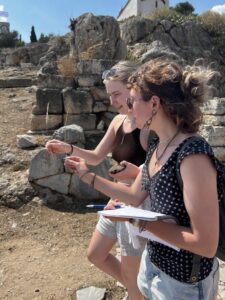 It was this initiation that makes up the most significant aspect of the cult, and leads to another facet that makes this site so interesting. Many of the artifacts show evidence of both Roman and Greek influence, and most elements at Eleusis had been rebuilt several times in antiquity. this is because of the long history of the site, but also because it was eventually taken over by Romans. (we got to use our favorite trick in identifying roman architecture: roman’s use brick, Greeks don’t!).
It was this initiation that makes up the most significant aspect of the cult, and leads to another facet that makes this site so interesting. Many of the artifacts show evidence of both Roman and Greek influence, and most elements at Eleusis had been rebuilt several times in antiquity. this is because of the long history of the site, but also because it was eventually taken over by Romans. (we got to use our favorite trick in identifying roman architecture: roman’s use brick, Greeks don’t!).
The Romans main incentive in controlling this site was that the cult formed a direct competition to christianity, promising much the same things like the choice to join, lack of hierarchy, and rewards in the afterlife. women were also allowed to join and made up a key aspect of the cult. this relation to contemporary religion was really interesting to me, as well as seeing combined aspects of cult worship and early christianity. We also learned about the wonders of Ancient Roman concrete, what hundreds of years of opening doors and wagon wheels does to marble, and what crude humor may have been like in the ancient world. We spent a lot of time exploring and asking questions at this site, the perfect end to the educational portion of our trip.
After traveling back to familiar Athens, we rested in the hotel and headed to a bittersweet farewell dinner back at Ella to enjoy delicious food and reminisce about our journey.
